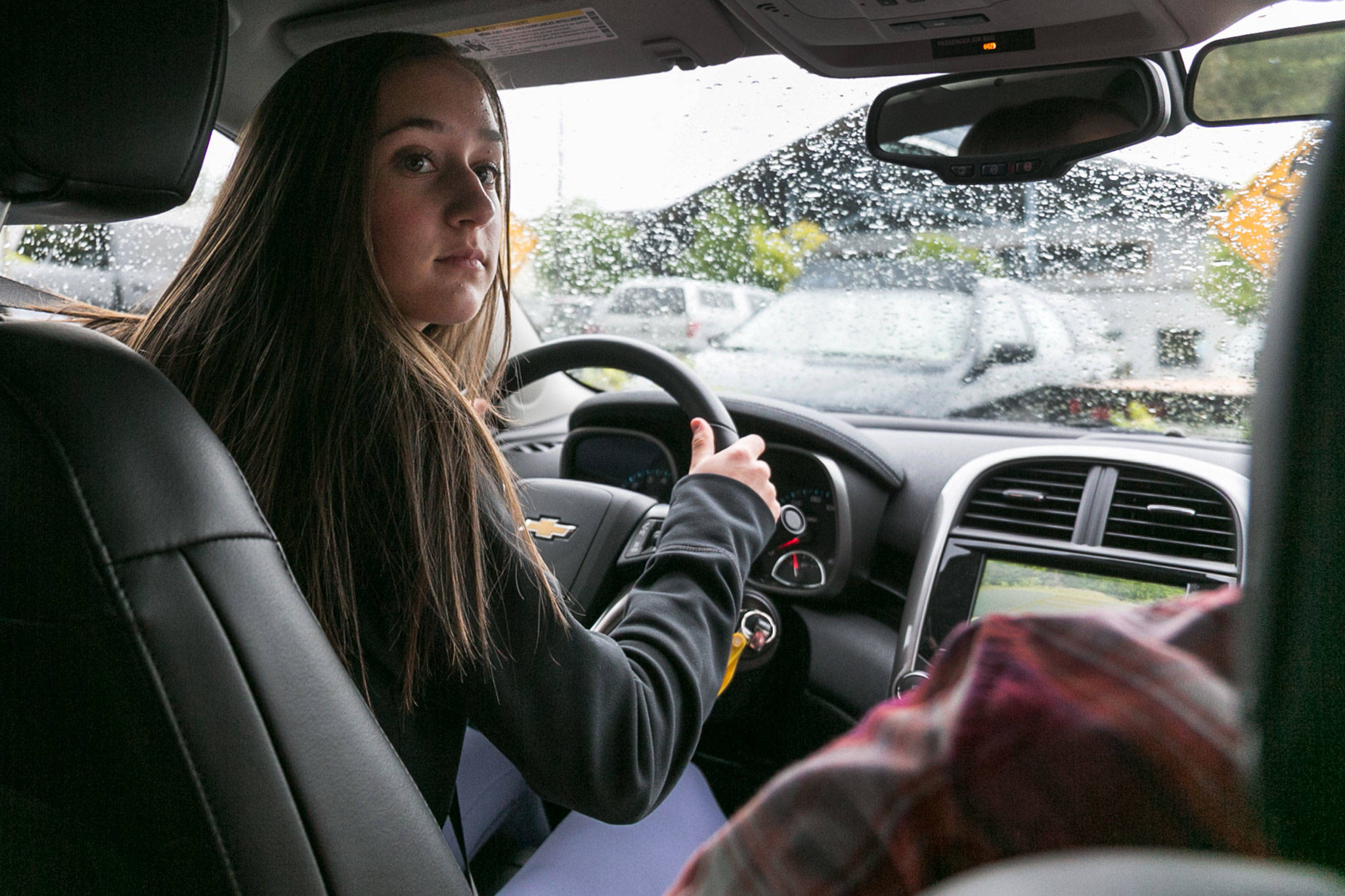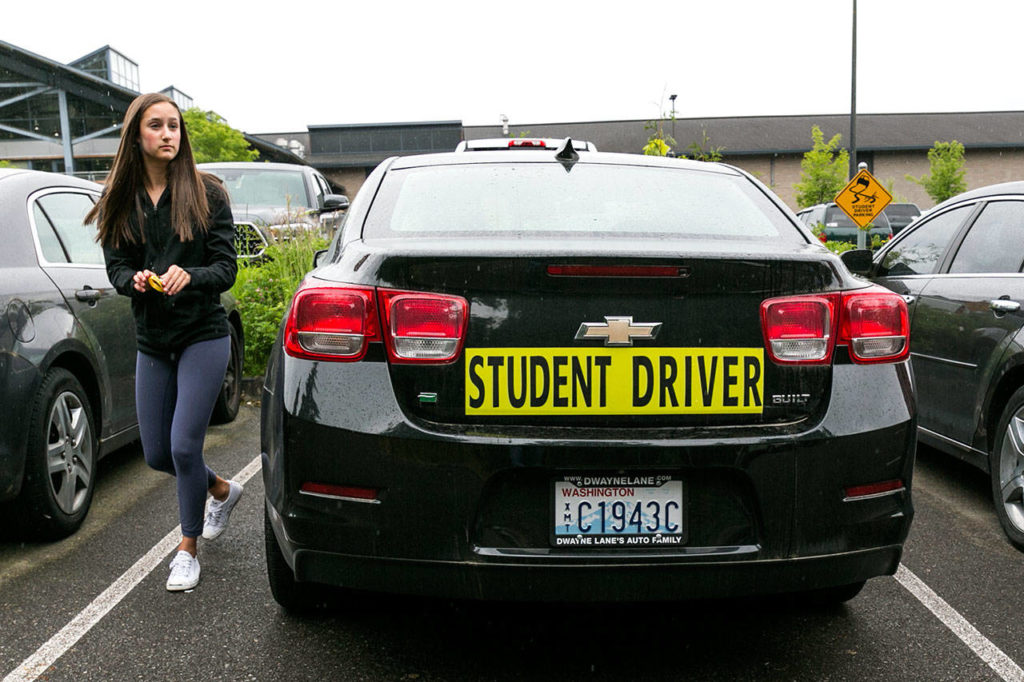EVERETT — Teens learning to drive soon will have new lessons, ones that go well beyond the rules of the road.
New curriculum is under development that aims to teach teens to think critically about their attitudes and behaviors, and how those affect their driving.
“There’s really nothing in driver education about that right now,” said Angie Ward, a program manager for the Washington Traffic Safety Commission. “What kind of driver are you? What things influence the way you drive? … What happens when you get on the road and somebody cuts you off?”
A specialist hired by the state Department of Licensing is putting together the list of core concepts, which likely will be rolled out over the next year.
The work is the result of a new state law that takes effect Aug. 1. Rep. Dave Hayes, R-Camano Island, was the chief sponsor.
The bill started elsewhere: as a way to hold public school programs better accountable by bringing them under the same oversight as commercial driving schools. The state Constitution prevents a full merger of those two programs, but the new bill seeks to at least bring consistency to a constantly evolving industry.
Traffic safety instructors and advocates see the move as a much-needed tune-up, and a signal of further changes to come.
Turning points
Driver education is coming back into favor after falling victim to a perfect storm of tight budgets, testing-focused school and academic studies questioning its effectiveness.
Arlington High School instructor James Brooke remembers when he started teaching driver ed in 1994.
Nearly every ninth-grader took the course. There were 45 hours of classroom time and seven hours behind the wheel. All for free, thanks to a pot of money filled by traffic fines.
“We had the best program in the United States,” Brooke said.
There’s no going back to that past, exactly.
But those tasked with achieving the state’s Target Zero goal (zero traffic fatalities or serious injuries by 2030) hope to beef up programs. It starts with bringing together the state’s two branches of driver education: public schools, overseen by the state superintendent’s office; and commercial schools, overseen by the Department of Licensing.
After curriculum, many see teacher training as the next step.
There’s a long list of ideas beyond that. What about a longer drive test? More behind-the-wheel time for students?
“We’re not done yet,” Hayes said.
The numbers
The need to make sure young people are ready to hit the road is apparent.
Crashes remain the leading cause of teen deaths, according to the National Highway Traffic Safety Administration.
In 2017, there were 2,685 collisions involving drivers age 16-20 in Snohomish County, an increase of 10 percent over 2014, according to the Washington State Patrol. More than one-quarter of the crashes resulted in injuries.
While older studies questioned the effectiveness of driver education, newer research shows that good driver education programs help.
Oregon is one example. That state has a robust driver training program that is partially subsidized by license-related fees.
Recent statistics show that while there are more crashes overall, Oregon teens who had driver education were far less likely to be the ones involved. Previous studies also showed those teens were less likely to receive traffic citations.
A Nebraska study showed similar benefits.
Signal changes
Still, more teens are waiting to get their driver’s license.
Arlington High School is among the few Snohomish County high schools to still offer traffic safety. The school serves about 225 teens each year. That’s far fewer than there were in 1994. The school used to see 150 teens in summer session alone.
One reason is a cultural shift.
“I could not wait to get my license,” Brooke said. “It’s a little different today. They’re so connected to their phones. Driving and meeting up with someone is not as motivating as it used to be.”
But there are other reasons. A big one is cost.
A family can pay anywhere from $400 to more than $900 for driver ed, depending on where they go. Public school programs average $450. Or they can wait until they turn 18 and skip the training.
A new model?
Meanwhile, the Bellingham School District has found a way to return to the past.
The district dropped traffic safety in 2001. Starting this fall, high school students can take a traffic safety class as part of the regular school day — for free.
The aim is to “even the playing field a bit for students and families who find the cost daunting,” said Jeff Tetrick, director of career and technical education programs for the district.
Because a regular class period yields twice as many hours as required for a typical traffic safety program, staff decided to pair it with financial literacy. Besides the rules of the road, the “Traffic Safety and Financial Education” class will teach students such basics as how to make a budget and secure insurance.
The district is spending about $250,000 to start the program, including buying cars, and budgeting for $72,000 in ongoing costs, Tetrick said.
Aging instructors
Bellingham’s move is “revolutionary,” said Alex Hansen, president-elect of the Washington Traffic Safety Education Association.
“If this is the beginning of a trend in Washington, then it will be a wonderful thing,” Hansen said.
In Snohomish County, the few remaining traffic safety programs are holdovers.
Some are in rural areas, like Darrington, where a commercial company is unlikely to profit.
By contrast, school programs aim to break even, said Joni Morrell, a program manager at Northwest Educational Service District 189, which runs traffic safety programs for the Granite Falls and Snohomish school districts.
Mike Shepherd still teaches driver education in Lake Stevens. The program charges $435.
“As long as we can stay in the black, we can have the program and they’ll support it,” Shepherd said.
Beyond budget, most of the remaining local programs also have continued because of passionate instructors like Shepherd.
For those teachers, retirement is on the horizon.
The six instructors who head up Stanwood High School’s program, for example, average 30 years of experience. The program is one of the few to go beyond the state’s minimum standards, with four extra hours of classroom time and six additional hours in a vehicle.
What happens when they leave?
“At this point, we are committed to providing a comprehensive (traffic safety education) program if we have students who want it and we have people certified to teach the program,” said Carolyn Coombs, an assistant principal.
Role models
Waiting and seeing is part of the reason driver education in Washington is not further along, according to Hansen, the traffic safety education advocate.
While he’s skeptical that more changes will be quick to come, he is glad for Hayes’ work and the new curriculum that is coming.
Granite Falls High School traffic safety teacher Tony Helgeson agreed it’s long overdue. Some of the curriculum he uses dates to the 1980s.
Helgeson, who’s been in it for 19 years, says teachers get regular training with experts, use current supplements and are committed to doing the job right.
“We’re in it for education and to make sure they bring applicable skills to the road,” he said.
The new curriculum will expand on what those skills are.
The work reflects a shift in how we think of driving, said Christine Anthony, a spokeswoman for the Department of Licensing. “Namely that driving is a privilege and not a right.”
Still, a change in “our cultural attitudes about driving” also is needed among those of us who have the license to drive, writes Doug Dahl, Target Zero Manager for Whatcom County at The Wise Drive blog.
The top factors in crashes involving teen drivers in our state are speeding, impairment and distraction.
The top factors for experienced drivers? The same three.
“If we want our young people to be safer on the roads, we can start by giving them a better example,” he said.
Melissa Slager: streetsmarts@heraldnet.com; 425-339-3432.
Talk to us
> Give us your news tips.
> Send us a letter to the editor.
> More Herald contact information.


























